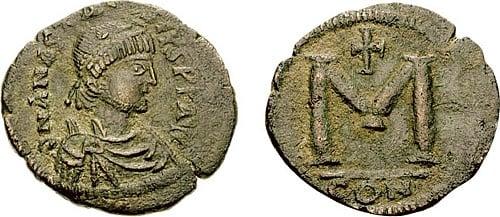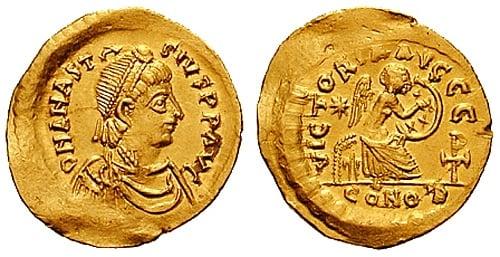Anastasios I ruled the Byzantine empire from 491 to 518 CE. Although his tax and monetary reforms were both popular and successful, the emperor could not repair the damaging split in the Christian Church created by his predecessors. He faced a major rebellion inside the empire and outside its borders, his military campaigns were as ineffective as his famous Long Wall in Thrace. Nevertheless, Anastasios did at least lay the foundations upon which the great Justinian I would build so spectacularly in the middle five decades of the 6th century CE.
Succession
Flavius Anastasios was plucked from the relative obscurity of his role as a court attendant and backed by Empress Ariadne to succeed her late husband Emperor Zeno (r. 474-491 CE). Zeno's heir Leo II had died prematurely in 474 CE and his elder brother Longinus was something of an unprincipled scoundrel so that legitimate candidates for the Byzantine throne were thin on the ground. Ariadne, herself the daughter of Emperor Leo I (r. 457-474 CE), ignored her late husband's advice and chose to marry Anastasios, already in his sixties. Longinus organised a rebellion of sorts, but it came to nothing, and he was exiled along with his Isaurian followers in 492 CE (Zeno having been the chief of this tribe from central Asia Minor). All of Zeno's family were banished, too, in a sweeping clean-up typical of the new emperor's thorough approach to all areas of his rule.
Military Campaigns
Anastasios had some limited success on the military front, managing to take back the fortress of Amida on the Byzantine frontier with Persia c. 504 CE after its conquest by the shah Kavad. The fortifications along the empire's eastern border with the Persians were further strengthened with the building of a new fortress at Anastasiopolis (Dara) between 505 and 507 CE. In 506 CE a peace was signed with the Persians.
Elsewhere was a different story. Theodoric, the King of Italy, was a powerful enemy of Byzantine interests in the western Mediterranean, even if Anastasios officially recognised him as king in 497 CE. Pannonia, a province in central Europe along the Danube, was a particular bone of contention between the two states with the Ostrogoths capturing Sirmium. Archaeological evidence suggests that several Byzantine fortresses were built along the Danube during Anastasios' reign and not, as traditionally held, by Justinian I (r. 527-575 CE). Anastasios also countered the threat from Theodoric by making Childeric, the king of the Franks in Gaul, an honorary consul and sending him a fleet to aid his war with the Ostrogoths in 507 CE.
The northern frontiers of the empire were attacked by the Bulgars from 493 CE, which led to Anastasios building his famous Long Wall to better protect Thrace. The wall extended from Selymbria on the north shore of the Sea of Marmara to the Black Sea and stretched some 45 kilometres. 65 kilometres from Constantinople, it was designed to protect the capital but, unfortunately, in the long term, it proved ineffective as earthquakes damaged portions of it and the garrison which was given the task of defending it proved to have less than top-notch troops. The lasting effect of the wall was more of a psychological one, and that on the Byzantines themselves, for it reminded everyone that the northern border of the empire was now practically the back door of Constantinople.
Internal Affairs
Anastasios might have lacked any royal pedigree, but he was not lacking in political and fiscal competence. The new emperor reformed the much ailing Byzantine coinage by introducing new and improved coins, notably the large copper follis, 288 of which were worth one gold nomisma, the standard coin against which all others were valued. Tax collection was reformed and the job given to state officials instead of local collectors. In a popular move in 498 CE, Anastasios abolished the chrysargyron, a tax on business transactions made by anyone from merchants to prostitutes - even beggars were liable. The tax had to be paid in gold or silver every four years, and its abolition resulted in a popularity boost for the emperor across his empire. The shortfall in the state coffers was made up by revenues from imperial estates and possibly a new tax, the chrysoteleia, which remains of uncertain purpose or application. All of these reforms certainly had the desired effect, and the state treasury could boast a surplus of 320,000 pounds of gold by the end of Anastasios' reign.

In religious affairs, Anastasios' interventions were markedly less successful and less popular than his financial reforms. The emperor's interest in theology went back to his time as a courtier when he delivered seminars in the Church of Hagia Sophia, so it was perhaps no surprise that he would use his new power to try and influence Church doctrine. In 482 CE Zeno had issued the Henotikon edict which had hoped to settle the dispute in the Christian Church of whether Christ had two natures (divine and human) or just one. The edict, never living up to its name 'The Edict of Unity', satisfied neither camp, and Pope Felix III felt strongly enough about it to condemn it and excommunicate the bishop of Constantinople, Akakios. The split became known as the Akakian Schism, and Anastasios could do nothing to repair it.
Indeed, the emperor's open support of Monophysitism (the one nature camp) and attempts to appoint like-minded bishops in major cities only inflamed matters and caused several public protests in Constantinople. One particular point of contention was the emperor's insistence that the Trisagion chant of the liturgy in eastern church services be amended so that the standard "holy God, holy strong, holy immortal, have mercy on us" received a final extension of "who was crucified for us" which suggested the divine nature of God was subject to suffering, an impossible position for Orthodox Christians. In 512 CE Anastasios won back the favour of his people by appearing in the Hippodrome of Constantinople, taking off his diadem before the 20,000 crowd and offering to retire if they would only name a successor. The clever soap-box politics worked, and nobody could think of any real reason to depose their emperor.
Rumblings of discontent continued, all the same, and the most serious consequence of the Monophysitism debate was the Vitalian revolt, named after the military commander who led the rebellion in Thrace between 513 and 515 CE. It was yet another example of how interlinked popular movements and Church dogma were in Byzantine life. Vitalian rode on a popular wave of orthodox feeling after Anastasios had tried to install a Monophysite bishop in Constantinople. The usurper's threat to the throne, although never realised, would not be removed until a conciliation with Justin I (r. 518-527 CE) and his assassination in 520 CE, probably under the orders of his rival, the future Justinian I. The ecclesiastical division between Rome and Constantinople would also have to wait for Anastasios' successor, when it was bridged, albeit temporarily, in 519 CE.
For the ordinary people, then, life under Anastasios had certain advantages, stability was always welcome, and there were not too many wars or invasions with their all-too-frequent horrors of pillage and premature deaths. Still, there was something lacklustre about the period and, as the historian J. J. Norwich here explains, life for the Byzantines under Anastasios lacked a little of the fun enjoyed under less religiously zealous emperors:
His chief defect was parsimoniousness - a failing which, combined with a strong puritanical streak, made Constantinople a duller place to live than ever before. Contests with wild beast were forbidden; citizens were no longer permitted to hold nocturnal feasts, on the grounds that they led to unbridled licentiousness - which indeed they very often did. (57-8)
Death & Successor
Anastasios, then in his nineties, died of natural causes in 518 CE and, not having any children, he was succeeded by Justin I. The aged and uneducated commander of the palace guard was, according to legend, selected by Anastasios merely because he was the first person to enter the emperor's chambers one morning. Justin would reign until 527 CE which then saw his nephew Justinian I take the throne who ushered in a new Golden Age for the Byzantine Empire, one that Anastasios I had laid the foundations for with his frugal and innovative fiscal policies.
